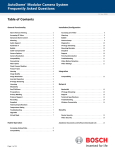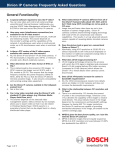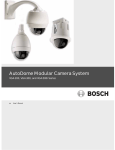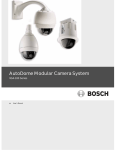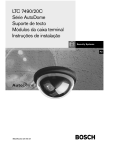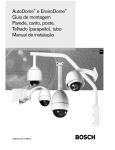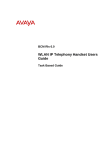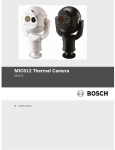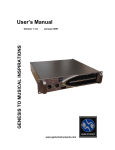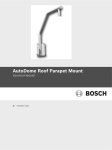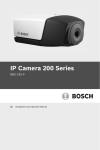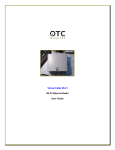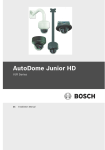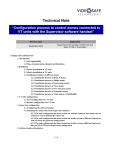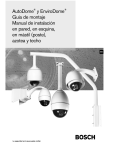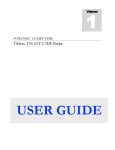Download Bosch Autodome FAQ`s
Transcript
AutoDome® Modular Camera System Frequently Asked Questions Table of Contents General Functionality Installation/Configuration Above Horizon Viewing . . . . . . . . . . . . . . . . . . . . . . . . . . . . . 2. Accessing IP Video . . . . . . . . . . . . . . . . . . . . . . . . . . . . . . . . . 2 Alarming . . . . . . . . . . . . . . . . . . . . . . . . . . . . . . . . . . . . . . . . . 9. Advanced Alarm Control . . . . . . . . . . . . . . . . . . . . . . . . . . . . 2 Bubble . . . . . . . . . . . . . . . . . . . . . . . . . . . . . . . . . . . . . . . . . . 9. Alarming . . . . . . . . . . . . . . . . . . . . . . . . . . . . . . . . . . . . . . . . . 2 Camera Setup . . . . . . . . . . . . . . . . . . . . . . . . . . . . . . . . . . . . 9. Audio Support . . . . . . . . . . . . . . . . . . . . . . . . . . . . . . . . . . . . 2 Diagnostics . . . . . . . . . . . . . . . . . . . . . . . . . . . . . . . . . . . . . . 10. AutoTrack II . . . . . . . . . . . . . . . . . . . . . . . . . . . . . . . . . . . . . . 2 IP Image Streaming . . . . . . . . . . . . . . . . . . . . . . . . . . . . . . . 10. Bubble . . . . . . . . . . . . . . . . . . . . . . . . . . . . . . . . . . . . . . . . . . 2 Mounting Brackets . . . . . . . . . . . . . . . . . . . . . . . . . . . . . . . . 10. Cable Compensation . . . . . . . . . . . . . . . . . . . . . . . . . . . . . . . 3 Snapshot . . . . . . . . . . . . . . . . . . . . . . . . . . . . . . . . . . . . . . . 10. Camera Options . . . . . . . . . . . . . . . . . . . . . . . . . . . . . . . . . . . 3 Time Synchronization . . . . . . . . . . . . . . . . . . . . . . . . . . . . . 10. Camera Resolution . . . . . . . . . . . . . . . . . . . . . . . . . . . . . . . . 3 Troubleshooting . . . . . . . . . . . . . . . . . . . . . . . . . . . . . . . . . . 11. Compatibility . . . . . . . . . . . . . . . . . . . . . . . . . . . . . . . . . . . . . 3 Video Motion Detection . . . . . . . . . . . . . . . . . . . . . . . . . . . . 11. Connectivity . . . . . . . . . . . . . . . . . . . . . . . . . . . . . . . . . . . . . . 3 Video Settings . . . . . . . . . . . . . . . . . . . . . . . . . . . . . . . . . . . 11. Fiber Optics . . . . . . . . . . . . . . . . . . . . . . . . . . . . . . . . . . . . . . 3 Fixed Camera Modules . . . . . . . . . . . . . . . . . . . . . . . . . . . . . 3. Freeze Frame . . . . . . . . . . . . . . . . . . . . . . . . . . . . . . . . . . . . . 4. Housing . . . . . . . . . . . . . . . . . . . . . . . . . . . . . . . . . . . . . . . . . 4. Image Quality . . . . . . . . . . . . . . . . . . . . . . . . . . . . . . . . . . . . . 4 Image Resolution . . . . . . . . . . . . . . . . . . . . . . . . . . . . . . . . . . 4. Accessing Live Video . . . . . . . . . . . . . . . . . . . . . . . . . . . . . . . 9 Integration Compatibility . . . . . . . . . . . . . . . . . . . . . . . . . . . . . . . . . . . . 12 Image Stabilization . . . . . . . . . . . . . . . . . . . . . . . . . . . . . . . . 4 Inverted Operation . . . . . . . . . . . . . . . . . . . . . . . . . . . . . . . . 4. IP Image Streaming . . . . . . . . . . . . . . . . . . . . . . . . . . . . . . . . 5 Licensing . . . . . . . . . . . . . . . . . . . . . . . . . . . . . . . . . . . . . . . . 5. Bandwidth . . . . . . . . . . . . . . . . . . . . . . . . . . . . . . . . . . . . . . 13 Modularity . . . . . . . . . . . . . . . . . . . . . . . . . . . . . . . . . . . . . . . 5 IP Image Streaming . . . . . . . . . . . . . . . . . . . . . . . . . . . . . . . 13 Pan/Tilt/Zoom . . . . . . . . . . . . . . . . . . . . . . . . . . . . . . . . . . . . 5. Support . . . . . . . . . . . . . . . . . . . . . . . . . . . . . . . . . . . . . . . . 13. Pre-positions . . . . . . . . . . . . . . . . . . . . . . . . . . . . . . . . . . . . . 6 Technical Specifications . . . . . . . . . . . . . . . . . . . . . . . . . . . 13. Privacy Masking . . . . . . . . . . . . . . . . . . . . . . . . . . . . . . . . . . . 6 Troubleshooting . . . . . . . . . . . . . . . . . . . . . . . . . . . . . . . . . . 14. Protocol Support . . . . . . . . . . . . . . . . . . . . . . . . . . . . . . . . . . 6 Wireless Connectivity . . . . . . . . . . . . . . . . . . . . . . . . . . . . . 14 Recording . . . . . . . . . . . . . . . . . . . . . . . . . . . . . . . . . . . . . . . . 6 Snapshot . . . . . . . . . . . . . . . . . . . . . . . . . . . . . . . . . . . . . . . . 6 Technical Specifications . . . . . . . . . . . . . . . . . . . . . . . . . . . . 6 Temperature Rating . . . . . . . . . . . . . . . . . . . . . . . . . . . . . . . . 7 Troubleshooting . . . . . . . . . . . . . . . . . . . . . . . . . . . . . . . . . . . 7 Device Security . . . . . . . . . . . . . . . . . . . . . . . . . . . . . . . . . . 15 Upgrades . . . . . . . . . . . . . . . . . . . . . . . . . . . . . . . . . . . . . . . . 7 Video Security . . . . . . . . . . . . . . . . . . . . . . . . . . . . . . . . . . . 15 Virtual Mask . . . . . . . . . . . . . . . . . . . . . . . . . . . . . . . . . . . . . . 7 Hybrid Operation Accessing Analog Video . . . . . . . . . . . . . . . . . . . . . . . . . . . . . 8 Compatibility . . . . . . . . . . . . . . . . . . . . . . . . . . . . . . . . . . . . . 8 Page of 15 Network Security AutoDome Modular Camera System Frequently Asked Questions General Functionality Above Horizon Viewing Alarming Q. How many inputs/outputs does AutoDome support? A. The AutoDome 300 and 500i Series can handle seven Q. I’ve heard that AutoDome will allow me to view “above the horizon,” but how? A. There is a decorative “skirt” on the pendant bubble which must be removed. Then inside the dome’s menus is an option for “Tilt Range Limit.” This can be adjusted up to a maximum of 17° above horizon. Accessing IP Video Q. Is special software required to view the IP video? A. You can view video and control all TCP/IP equipped AutoDome camera settings using Microsoft Internet Explorer. Additionally, you may use Bosch VMS or alarm inputs, two of which can be programmed for EOLR (End-of-Line Resistor) supervision to sense if a contact is open or closed and whether a wire has been tampered with. In addition, the 300 and 500i Series support four outputs: one relay rated at two amps and three additional open collectors. Audio Support Q. Do the IP versions have audio capability? A. Yes. One-way audio is possible. With the IP version the Biphase lines can be used as a microphone input. Of course once you do this, you can no longer use Biphase. VIDOS Video Management systems or DiBos 8.0 DVR to view and record video from the AutoDome IP camera. Q. How many users (simultaneous connections) are available to the IP video stream? A. All AutoDome cameras equipped with the TCP/IP AutoTrack II Q. Can AutoTrack II be used in outdoor environments? A. Yes. AutoTrack II incorporates Bosch’s exclusive “virtual Communications Module support multi-unicast, masking” technology, making it well suited to both multicast and streaming modes. The answer depends indoor and outdoor environments. on the encoder’s settings and the capabilities of the network; 5 simultaneous users when in multi-unicast mode, up to 25 simultaneous users when in multicast mode. Advanced Alarm Control Q. What is Advanced Alarm Control (AAC)? A. Advanced Alarm Control uses a sophisticated rulesbased logic engine to determine how to manage alarms. In its most basic form, a “rule” could define which input(s) should activate which output(s). In a more complex form, inputs and outputs can be combined with pre-defined or user-specified keyboard commands to perform advanced dome functions. Page of 15 Q. On which AutoDome models is AutoTrack II available? A. AutoTrack II is a standard feature on AutoDome 500i Series domes. Bubble Q. What is the material the bubbles are made of? A. Polycarbonate specially coated for scratch resistance. AutoDome Modular Camera System Frequently Asked Questions Cable Compensation Compatibility Q. What is “cable compensation”? Q. Can I view video recorded using the AutoDome IP A. Available on AutoDome 300 and 500i Series domes, Cable Compensation allows you to increase coax wiring distances by as much as 40% with no reduction in with standard PC video players (e.g. Windows Media Player, QuickTime, etc.)? A. This answer depends on the selected video the video output level. Cable Compensation improves management system. DiBos (Version 8), for example, image quality and reduces installation costs. allows you to export video so that it can be viewed in Windows Media Player. VIDOS exports in a proprietary format that can be played back in a freely distributed Camera Options video player. Q. What determines the IP video format of NTSC or PAL? A. This is determined by the camera’s CCD imager. In NTSC cameras the imager runs at 30 ips, and in PAL models at 25 ips. This ensures that the image frequency matches the power frequency (60Hz for NTSC, 50Hz for PAL) so that the AutoDome camera delivers the Connectivity Q. There is an RJ45 connector on the interface board. Is this for an Ethernet connection? A. It depends on which model you have or, more best possible image. It also ensures compatibility with specifically, which Communications Module is inside existing analog video equipment. the unit. If there is an TCP/IP module, then yes, this is Q. Is there an equivalent of a G3Basic for outdoor use? A. Yes. The 200 Series has an outdoor (EnviroDome) an Ethernet connection. If not, then this is an ANALOG UTP video connection which can cause video problems if an Ethernet (or any unterminated cable) is inserted. housing option. Fiber Optics Camera Resolution Q. What resolution options are available on the various AutoDome camera modules? Q. Does the new AutoDome support the same fiber optic modules as its predecessor? A. Yes. A. All AutoDome Camera Modules provide high-resolution images. Fixed camera modules deliver 540 TVL of horizontal resolution, while the PTZ camera modules deliver up to 470 TVL. Fixed Camera Modules Q. Do the AutoDome Fixed Camera Modules utilize Dinion imaging technology? A. Yes. The AutoDome 100 Series Fixed Camera Modules feature Bosch’s award-winning Dinion imaging technology. Both Color and Day/Night Fixed Camera modules utilize integrated Dinion 15-bit imaging and unique XF wide dynamic range technology. Page of 15 AutoDome Modular Camera System Frequently Asked Questions Freeze Frame Image Resolution Q. What is the new “freeze frame” option? Q. What is the relationship between CIF resolution and A. When the dome moves from shot to shot, there is now the option to freeze the image until the next position is TV lines? A. There is no relationship. CIF denotes the amount reached. This eliminates the blurry images associated of pixels in the compressed image. Television Lines with that movement. It also reduces storage needed on (TVL) denotes the capability of the imager to resolve some DVRs and bandwidth usage in IP-based systems. small details. The actual details shown in the image depend on the compression and bandwidth settings. However, by having up to 540 TVL imager resolution the Housing Q. What is the material the sunshield is made of? A. It is actually a high-impact polycarbonate material. It helps keep heat away from the main cast aluminum housing. It cannot be dented or broken, and it can be painted. Q. Is it possible to paint the dome and sunshield a AutoDome cameras are capable of providing unmatched sharpness in the image, all tunable via the camera’s settings page. Q. MPEG-2 gives the best picture quality. Can I use this with the AutoDome IP cameras? A. MPEG-4 delivers equally good images as MPEG-2 in 4CIF resolution and uses between 15% and 30% less bandwidth than MPEG-2. In addition lower frame rates different color? Would the sunshield require special are available with MPEG-4, while MPEG-2 is limited to primers? real time. A. Yes, they can be painted. The shield is already painted, so no primer would be required to repaint. Q. What is the purpose of the plastic shroud for the power supply box? A. It is purely decorative for the wall-mounted version with the arm. It gives the box a “cleaner” look against the wall rather than looking like just a square box. It serves no functional purpose. Image Stabilization Q. Is camera sensitivity reduced when the Image Stabilization feature is enabled? A. No. Unlike other stabilization solutions, use of the stabilization feature has no impact on AutoDome camera sensitivity. Image Quality Inverted Operation Q. Is the quality of the images transmitted over the Q. Does the AutoDome support inverted camera TCP/IP network as good as those from a conventional analog AutoDome camera? A. Absolutely. Using 4CIF resolution at 25/30 ips it is almost impossible to tell if the picture displayed on the monitor is traditional composite analog video or the compressed IP video stream. Page of 15 operation? A. Yes, AutoDome PTZ models can be mounted upside down. Both image and control can be configured for inverted operation to provide natural camera operation. AutoDome Modular Camera System Frequently Asked Questions IP Image Streaming Licensing Q. Can the AutoDome IP stream JPEG and MPEG4 to Q. If special software is required to view video via web different devices? A. Yes. Bosch’s innovative tri-streaming feature enables browser, does this software require a license? A. An ActiveX component is required. This ActiveX AutoDome IP to generate two independent MPEG-4 component does not require a license and is streams and a JPEG stream simultaneously. Each of automatically downloaded from the AutoDome when these streams can be sent to separate devices. For connecting from Internet Explorer. example, one stream could send low bandwidth CIF images to a remote central monitoring station, one stream could send 4CIF images to a local VIDOS NVR or DiBos DVR for recording, and a third stream could send JPEG images to a PDA device. Q. How do I decide whether to use MPEG-4 or JPEG? A. MPEG standards were developed for moving pictures and are designed to optimize streaming video performance. JPEG was developed for still images. Modularity Q. Can I move AutoDome Camera Modules between housings? A. Yes. All AutoDome Camera Modules are “hotswappable,” allowing you move cameras (fixed and PTZ) between housings. When using JPEG in streaming video applications, each individual frame or image must be encoded. MPEG differs from JPEG in that it uses interframe Pan/Tilt/Zoom encoding which further compresses the video data by Q. Do TCP/IP versions of AutoDome support Power over only encoding the differences (e.g. the pixels that have changed) between periodic key frames. MPEG-4 is the compression method of choice for all normal video Ethernet (PoE)? A. No, the current IEEE 802.3af standard limits Power over viewing and recording over network as it is optimized Ethernet output to 15 watts, which is insufficient to for video, leading to lower bandwidth requirements. support AutoDome PTZ operation. JPEG is generally only chosen for special tasks such as sending snapshots to an FTP server. Q. Why do the TCP/IP versions of the AutoDome have both MPEG-4 and JPEG streaming? A. MPEG-4 provides better quality video at lower bandwidth. JPEG can be viewed with standard decoders available in the operating systems (e.g. on a PDA or with third-party video management systems). Page of 15 Q. Does the AutoDome provide digital zoom capabilities? A. Yes. The 300 and 500i Series provide up to 12x of digital zoom once the optical zoom range of the camera has been reached. AutoDome Modular Camera System Frequently Asked Questions Pre-positions Recording Q. What is a “custom” pre-position tour? Q. I have recorded an .mp4 archive onto my hard disk. A. The standard pre-position tour simply shows each shot sequentially. You can add or remove shots, but they are How can I play this back? A. The MPEG player can be downloaded for free from still shown in sequence. The “custom tour” allows the the Bosch Security Systems website: http://www. user to define which shots are visited when and how boschsecurity.us/software.cfm?expandprdctgroup=359 often. &expandfamily=100&expandprdct=3428 Q. How many pre-positions does AutoDome support? A. The AutoDome 200 Series supports up to 64 userdefined presets. The 300 and 500i Series support up to 99 user-defined presets. Snapshot Q. Does the camera provide the ability to capture a single image (i.e. snapshot)? A. Yes, directly from the live view page. Privacy Masking Q. How many privacy masks does AutoDome support? A. AutoDome 300 and 500i Series domes support up to 24 individual privacy masks (up to 8 masks per scene). Q. What is the purpose of “blurred” privacy masks? A. Blurring is useful when privacy must be maintained but determining the presence of motion is required. Q. Can privacy and virtual masks be configured with multiple corners (vertices)? A. Yes. AutoDome masks can be programmed with up to five corners to cover more complex shapes. Technical Specifications Q. Is the AutoDome IP camera the same size and shape as conventional AutoDome cameras? A. Yes. The TCP/IP Communications Module fits inside any of the AutoDome housings; thus the mechanical dimensions of the IP models are identical to the equivalent analog model cameras. Q. Other than IP video, do these units have the same features as the respective AutoDome models? A. Yes all imaging features are present, but since these are network cameras they do not support Bilinx or coax cable compensation features of the standard analog Protocol Support Q. Does AutoDome support Pelco communications protocols? A. Yes. Pelco P and D are supported with an auto detect baud rate, so the dome will set itself according to the Pelco Data it sees on the RS485 bus. Page of 15 AutoDome camera models. Q. What type of MPEG-4 compression is used (e.g. H.263, MPEG-4 Part 2, proprietary, etc.)? A. MPEG-4 Part 2. AutoDome Modular Camera System Frequently Asked Questions Temperature Rating Virtual Mask Q. What is the operating temperature range for the new Q. What is a “virtual mask” and how does it differ from a AutoDome models? privacy mask? A. A. Virtual masks are similar to privacy masks in that they Indoor Pendant EnviroDome EnviroDome w/ XT heater kit Series In-Ceiling 100 Series 14°F to 122°F –10°C to 50°C 14°F to 122°F –40°F to 122°F –10°C to 50°C –40°C to 50°C –67°F to 122°F –55°C to 50°C 200 Series 14°F to 122°F –10°C to 50°C 14°F to 122°F –40°F to 122°F –10°C to 50°C –40°C to 50°C –76°F to 122°F –60°C to 50°C 300 Series 14°F to 122°F –10°C to 50°C 14°F to 122°F –40°F to 122°F –10°C to 50°C –40°C to 50°C –76°F to 122°F –60°C to 50°C 500i Series 14°F to 104°F –10°C to 40°C 14°F to 104°F –40°F to 122°F –10°C to 40°C –40°C to 50°C –76°F to 122°F –60°C to 50°C Troubleshooting Q. When I open Internet Explorer to view video from the TCP/IP equipped AutoDome camera, it asks for an MPEG ActiveX component. Where do I get it? A. The ActiveX component is supplied with the camera on the CD. If you have lost the CD or need the latest version, go to the Bosch website where it can be downloaded for free: http://www.boschsecurity.us/ software.cfm?expandprdctgroup=359&expandfamily=10 0&expandprdct=3429 Upgrades Q. Can AutoDome 100 Series domes be upgraded to add PTZ functionality? A. Yes, all AutoDome modules are completely interchangeable. Simply upgrade to the 200, 300 or 500i Series CPU Module and add a Color or Day/Night PTZ Camera Module. Page of 15 can be “drawn” around a specific object, contain up to 5 vertices, and will automatically resize as the dome pans, tilts, and zooms. However, virtual masks are not visible to the user. Instead, they mask out areas from the AutoTrack and Video Motion Detector software and are used to “hide” unwanted motion such as trees or high-traffic areas. AutoDome Modular Camera System Frequently Asked Questions Hybrid Operation Accessing Analog Video Q. What receivers are required to view the IP video on an analog monitor? A. VIP-XD if full 4CIF real time images are required. VIP-XD can also display quad image from 4 cameras. Q. Why is there still a coax connector connection on the TCP/IP equipped AutoDome cameras? A. This connection can be used to provide simultaneous connection to both IP-based and conventional analog systems. Q. Can it be used point to point to an analog monitor, or VGA monitor? A. Yes. Use a VIP XD Decoder. Q. Can I view analog pictures simultaneously with live viewing over the network? A. Yes. Compatibility Q. Is a hybrid AutoDome IP camera compatible with Bilinx control over the coax? A. No. It is not compatible, but the full Bilinx-style functionality is available over the IP network via the built-in html setting pages. Page of 15 AutoDome Modular Camera System Frequently Asked Questions Installation/Configuration Accessing Live Video Q. Can you create customized web pages for viewing live video? Q. How do you remove the bubble from the in-ceiling models? A. Loosen, but do not remove, small screw in side of trim ring with small Phillips screwdriver and rotate bubble counter-clockwise. A. No, this will be offered in the future via a web tool kit. Camera Setup Alarming Q. Is there a faster way to exit lengthy menus? Q. How do I make an alarm trigger an action/event? A. Yes, use the ZOOM function to jump to EXIT. A. It is a three-step process. First: Define the input under Q. Can I use the CTFID with the IP version of the dome? “Input Setup.” Second: Define output under “Output Setup.” Third: Create a rule under Rule setup which links the input(s) to the desired output(s) Q. Is the camera capable of making an IP video connection triggered by alarm or motion? A. Yes. Q. Do the IP versions of AutoDome transmit the the alarm input data with the video? A. Yes, AutoDome IP cameras support this functionality. Q. Can I switch the output relays remotely over network? A. Yes. A. The CTFID uses Bilinx (up the coax) to communicate with the dome which the IP version does not support. However, all of the screens supported in the CTFID are included in the IP web server and therefore you have all the same functionality accessible using Microsoft Internet Explorer. Q. For TCP/IP models, what camera settings are available over the browser interface? A. All camera settings are directly available via the html settings pages. Q. How will the programming of the camera be accomplished for IP addresses and network function? A. Via the Configuration Manager Utility or via the html settings pages. Bubble Q. Can I order a rugged bubble? A. All AutoDomes are supplied with rugged bubbles as a standard feature. Q. How do you remove the bubble from the pendant models? A. Push in tab with small screwdriver and rotate bubble counter-clockwise. Page of 15 Q. For TCP/IP models, how will the programming of the camera be accomplished for camera feature set (similar to Bilinx)? A. Via the Configuration Manager Utility or via the html settings pages. Q. What is the factory default TCP/IP address on AutoDomes equipped with a TCP/IP Module? A. 192.168.0.1, the same as all Bosch Video over IP (BVIP) devices. AutoDome Modular Camera System Frequently Asked Questions Diagnostics Snapshot Q. What do the different LEDs inside the bubble tell me? Q. Can the camera send a snapshot image (SMTP, HTTP, A. The different LED signals represent different events. LED Signal Event Green LED (ON steady) Video is coming from Camera Module. Red LED . (5 sec ON – 0.5 sec off) CPU is running. Red LED (ON steady) CPU is locked. Amber LED (ON steady) Good packets of data are received over Biphase, RS232 or RS485. Amber LED (ON steady) IP communications module is being used . and is communicating properly internally. Amber LED (Blinking) Bad data or data addressed to another camera is received. FTP, PDA, etc.) on an alarm (video motion detection, dry contact, etc.)? A. Yes, this can be accomplished via an http request. For example http://IP-address/snap.jpg. Support Q. Is there a tool/utility to push firmware updates to multiple IP-enabled AutoDome cameras simultaneously? A. Yes, the VIDOS video management system can be used to simultaneously push firmware updates to multiple AutoDome IP cameras. IP Image Streaming Q. Can you set a limit for the number of allowable simultaneous connections? A. No, the number of connections is depending on the transmission mode you choose. Time Synchronization Q. Can you synchronize camera time/date with a specific PC or DVR? Network Time (NTP) Server? A. Yes, the AutoDome IP supports the time protocol (RFC 868). Mounting Brackets Q. Can Gen3 mounting brackets be used? A. The existing (Gen3) AutoDome Wall Mount Pendant Arm is not compatible with the new AutoDome Modular Camera System, but the mounting hole pattern is the same from old to new. The Mast (LTC 9541/01), Corner (LTC 9542/01), and Flat Roof Adapter Plate (LTC 9230/01) from the Gen3 Series AutoDome can be used with new AutoDome cameras. The Roof (Parapet) and Pipe Mount from the Gen3 Series are not compatible with the new AutoDomes, but Gen3 Roof Mounts can be converted by ordering a new-style Pipe Mount Adapter (VG4-A-9543). Page 10 of 15 AutoDome Modular Camera System Frequently Asked Questions Troubleshooting Video Settings Q. Are there tools to determine if the camera is getting Q. What resolution (image size) settings are available on enough power? A. Yes, the AutoDome’s OSD will flash a message on the video if the dome voltage drops below acceptable voltage limits. The dome also provides an advanced built-in diagnostic utility which monitors and reports on camera voltage levels. Q. I’m dropping frames and getting artifacts. What should I do? A. Take a look at the encoder settings. This might happen if you are attempting to send large images at high frame rates but have set the bandwidth and quality settings very low. It may it may be that the data rate required to deliver the desired settings is too high for the bandwidth that is available on the network. Try using a smaller image size or lower frame rate and see if performance improves. If not, this might also indicate a network congestion problem. Video Motion Detection Q. How many motion detection “zones” or “areas” can you create? A. The 500 Series supports up to 10 motion detection presets. (Preset shot positions 90 – 99). Q. Are the video motion detection “zones” or “areas” individually configurable? A. Within each of these, a specific “region of interest” can be defined and “virtual masks” can be used to ignore motion in specified areas. Page 11 of 15 the AutoDome IP-enabled cameras? A. Each AutoDome IP camera supports 4CIF (full imager resolution), 2CIF, 1/2 D1, CIF and QCIF. Q. Can individual video clients use different image settings (i.e. different image sizes, image quality settings, and frame rates)? A. No, but each AutoDome IP camera can deliver up to three independent IP video streams. The image settings (image size, quality, frame rate, etc.) for each IP stream can be configured independently. AutoDome Modular Camera System Frequently Asked Questions Integration Compatibility Q. Does Bosch provide DVRs to record the IP video of these cameras? A. The DiBos 8.0 is capable of displaying and recording IP video streams from up to 32 Dinion IP camera connections. In addition, AutoDome IP video can be recorded on VIDOS Network recorder or directly to an iSCSI RAID array. Q. What is iSCSI? A. iSCSI, pronounced eye-skuzzy, a protocol that serializes SCSI commands and converts them to TCP/IP for transmission across a network. Q. Is the AutoDome IP version compatible with other manufacturers’ products? A. It is possible to integrate the JPEG video stream to virtually any third-party JPEG or MJPEG-compatible video management systems. Page 12 of 15 AutoDome Modular Camera System Frequently Asked Questions Network Support Bandwidth Q. Does it support SNMP so that it can be managed by Q. How much bandwidth is required on the network for each IP video stream? my network management tools? A. Yes. A. AutoDome IP cameras can be configured for specific bandwidth targets and limits. You can scale the bandwidth from 10Kbps to 10Mbps. The amount of bandwidth required per camera depends on image Technical Specifications Q. Are there any wiring distance limitations for size, frame rate, the quality settings (e.g. amount of AutoDomes equipped with a TCP/IP Communications compression) selected, and the activity levels within Module? the scene. If we assume CIF resolution and medium activity levels, bandwidth will average between 100 and 500Kbps. If we assume 4CIF resolution and medium activity levels, bandwidth will average between 400Kbps and 2Mbps. Q. Does the bandwidth requirement on the network increase with multiple connections? A. Each multi-unicast stream needs its own bandwidth. For example, three recipients viewing a 1Mbps video stream will consume 3Mbps of network bandwidth. In multicast mode, each additional stream consumes nearzero additional bandwidth, so the three recipients will demand only 1Mbps from the encoder. Q. Can you configure bandwidth limits for AutoDome IP cameras? A. Yes, via the camera settings page. IP Image Streaming Q. Does the AutoDome IP support unicast streaming? A. Yes. Q. Does the AutoDome IP support multicast streaming? A. Yes. Q. Does the AutoDome IP support broadcast streaming? A. No. Page 13 of 15 A. The IEEE 802.3 standard limits Ethernet communications over Cat5e/Cat6 UTP copper to 100m (328ft.). If your application has cameras beyond the 100-meter reach of copper, a remote data closet would be needed. Alternatively, a UTP to fiber optic media converter can be used to extend wiring distances from 2km (6,560ft.) to 5km (16,400ft.) or more. Q. Does the AutoDome IP support DHCP? A. No. Q. Does the AutoDome IP support DNS? A. Yes. AutoDome Modular Camera System Frequently Asked Questions Troubleshooting Wireless Connectivity Q. What should I do when I can’t view the AutoDome IP Q. Can the AutoDome IP camera transmit a wireless camera over the network, but it responds to IP ping command? A. Since you can ping the camera, it is configured video signal? A. AutoDome IP cameras can be connected to any 802.11compliant device point (multipoint) or access point correctly for the network and has a unique IP address. (point-to-point) RF link for wireless video streaming The next step is to open Internet Explorer and point it from remote camera sites. AutoDome IP can also be at the camera, confirm that the camera delivers a web integrated with various licensed RF, microwave and page and then view the MJPEG video stream. If you can laser-based wireless transmission technologies. view the MJPEG stream but not the MPEG-4 streams, verify that you have the latest Bosch MPEG-ActiveX driver installed. If the MPEG-ActiveX driver is installed and you still cannot see the video, you may need to adjust your firewall settings. Q. A few people want to view the same camera. How do I configure multicast on our switch? A. Configuring a managed switch to support multicast requires some additional understanding of how the switch works. Please refer to the switch’s user manual. Q. I do not have Java installed. Where can I get this? A. The Sun Java components can be downloaded for free from http://java.sun.com/products/plugin/downloads/ index.html Q. I do not have DirectX 9.0 installed. Where can I get it? A. The latest DirectX version is available from the Bosch website: http://www.boschsecurity.us/software.cfm?ex pandprdctgroup=359&expandfamily=100&expandprdct =3426 Page 14 of 15 AutoDome Modular Camera System Frequently Asked Questions Security Device Security Q. Can you restrict access to the IP-enabled AutoDome cameras (e.g. setup user accounts, IP address filtering, etc.)? A. Yes, there are three user levels, each with their own password and authorizations. Q. Can you configure the AutoDome IP to use specific network ports (e.g. use an http port other than 80, etc.)? A. Yes, communication can be switched to TCP Port 80. All the data will then tunneled through TCP Port 80. Video Security Q. Is the camera’s video stream encrypted to prevent unauthorized viewing? A. No, there is no encryption inside the AutoDome IP, but it is possible to use third-party devices to encrypt the data stream coming out of the AutoDome IP. It is also possible to set up different user levels with different access rights/privileges on the AutoDome IP. Page 15 of 15















